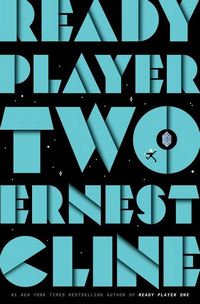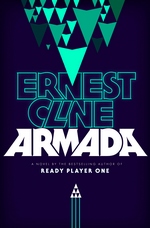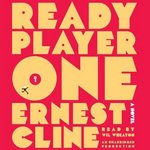 |
Ready Player Twoby Ernest Cline Hardcover, 336 pg. Read: January 4-8, 2021 |

Like Marty McFly, I woke up at exactly 10:26 a.m., to the song “Back in Time” by Huey Lewis and the News.
This was courtesy of my vintage flip-clock radio—a Panasonic RC-6015, the model Marty owns in the film. Id had it modified to play the same song at the same time Marty hears it, after he finally makes it back to the future.
I threw back the silk sheets of my king-size bed and lowered my feet to the preheated marble floor. The house computer saw that I was awake and automatically drew back the bedroom’s wraparound window shades, revealing a stunning 180-degree view of my sprawling woodland estate, and of the jagged Columbus skyline on the horizon.
I still couldn’t quite believe it. Waking up in this room, to this sight, every day. Not long ago, just opening my eyes here had been enough to put a grin on my face and a spring in my step.
But today, it wasn’t helping. Today I was just alone, in an empty house, in a world teetering on the brink of collapse.
What’s Ready Player Two About?
While still basking in the immediate afterglow of his victory, sudden power, and fame, Wade Watts discovers a secret innovation that OASIS founder James Halliday had tucked away for the winner of his contest.
Some see this new tech as a giant leap forward and a way to lay the groundwork for saving humanity from the worsening climate crisis, food shortages, and so on. Others see it as a tool to distract people and divert resources from better solutions to the problems that plague the world.
Releasing this tech had an unintended consequence—a new riddle from Halliday. No one was sure what the prize would be, but after his last riddle, who could pass it up? This one didn’t focus on the life and interests of James Halliday, or even Og (Halliday’s former partner and Wade’s new friend), but on Kira Morrow—the other member of GSS’s founders. Og’s wife and the great unrequited love of Halliday’s life.
Years go by, no one makes a lot of progress on that riddle—Wade’s group grows apart, teens grow into adults and friendships take on different meanings (well, there’s one splintering, but the rest are from growth). And then one day, something happens to force Art3mis, Shoto, Aech, and Parzival to regroup and get serious about solving this riddle, or they—and millions of others—would die.
A Very 80s Sequel
The general approach to 80s movie sequels seems to be, “the same as the original, but just different enough to justify the new movie.” And that’s really what we got here. Instead of Halliday’s Easter Eggs, we get the Seven Shards to find. Instead of Joust, we get Ninja Princess; instead of Rush, we get Prince; instead of Steven Spielberg, we get John Hughes; and so on.
Now, I liked the basic game design in the first book and it worked almost as well here. Some of the elements were great—like where the group had to go back to the pre-K level education planet and work through some of those games (and got to ride The Great Space Coaster!). I loved the John Hughes material (even stuff from movies I haven’t seen/obsessed over—which are the minority). But others didn’t work as well for me—the Sega Ninja/Ninja Princess bit seemed a bit too much like the Joust section—and even throwing in the twist to make it hard for Wade, it wasn’t that interesting. And don’t get me started on the interminable Prince* chapter—it felt like it was 110 of the 336 pages in this book.
* And no, it’s not just because I’m not a Prince fan—I probably like more of his songs than Rush’s. Which isn’t saying a whole lot.
Thematically this was the way to approach this book—it’s as 80s as you can get. It plays to Cline’s strengths, too. But, I wanted something newer, fresher in this book, and it just wasn’t there.
LØhengrin
Along the way, Wade makes a new friend, LØhengrin. She’s a young gunter, working hard on this second riddle, a popular YouTuber, and an unabashed fan of Wade’s (her avatar’s name is a clear tribute to his Parzival). Without her, Wade wouldn’t have made the progress he did before the threat—and it’s unlikely he’d have completed it.
The arc concerning LØhengrin and her crew is probably the best thing about this novel, actually. Which is only the secondary reason I have for mentioning her.
My primary reason is the voice-over that opens each episode of her YouTube show:
“Some people define themselves by railing against all of the things they hate, while explaining why everyone else should hate it too. But not me. I prefer to lead with my love—to define myself through joyous yawps of admiration, instead of cynical declarations of disdain. “
I just love the way that’s put. I should be more like that.
So, what did I think about Ready Player Two?
It was better than the Ready Player One movie. I should start there.
Unless you’ve been reading this blog since 2014, you won’t have seen me fanboy over Ready Player One (and even that was listening to the audiobook for my third time through the book). I get many of the criticisms and complaints readers have had over the book—and I share none of them. For me, it was a pure joy from beginning to end. I loved it. Which suggests that I’d be the ideal reader for this one, right? Wellllll…sort of.
Even if it doesn’t sound like it, this book was a lot of fun, and I enjoyed the whole thing. I’ve liked these characters and this world for a decade now, and getting to spend some more time with them was a blast.
But…it was too much of a re-hash. As a certain Canadian Band sang, “It’s all been done before.” The higher stakes didn’t feel that real—the motivation seemed hollow, you didn’t read this worried that millions were going to be killed, it’s not that kind of book, so it didn’t seem as urgent. Wade’s narration at the beginning of Ready Player One tells us from the get-go that he’s writing about how he won—so there’s no worry that he’ll fail there, either. Somehow, though, I felt more suspense through all of that book than this.
I thought Cline did a better job of some of the emotional/psychological material in this book—Wade’s (and Samantha’s) motivations and reactions to events and people are dealt with a greater subtlety and authenticity than Cline showed in his first novel—and Wade’s emotional maturity–eventual as it may be–is really portrayed well (we’re never really shown where his friends needed it).
Actually, that point could probably be generalized to the book as a whole—the writing is probably better, it’s a higher quality prose. But, I still think the book is lesser.
Completists are going to want to pick this up—and they should, as long as they go in with low expectations. But on the whole, you’d be better off reading the previous one again (or for the first time)

This post contains an affiliate link. If you purchase from it, I will get a small commission at no additional cost to you. As always, opinions are my own.
![]()



 This was fun, loads of fun. Not as good as Ready Player One — not sure it could’ve been, so let’s just take that off the table. But, it taps into the same vein of pop culture, gaming, and a desire for something that’s missing — family, father, social acceptance, etc. You take these elements, add a sense of humor and an adventure-driven plot and you get a winning read.
This was fun, loads of fun. Not as good as Ready Player One — not sure it could’ve been, so let’s just take that off the table. But, it taps into the same vein of pop culture, gaming, and a desire for something that’s missing — family, father, social acceptance, etc. You take these elements, add a sense of humor and an adventure-driven plot and you get a winning read. 
